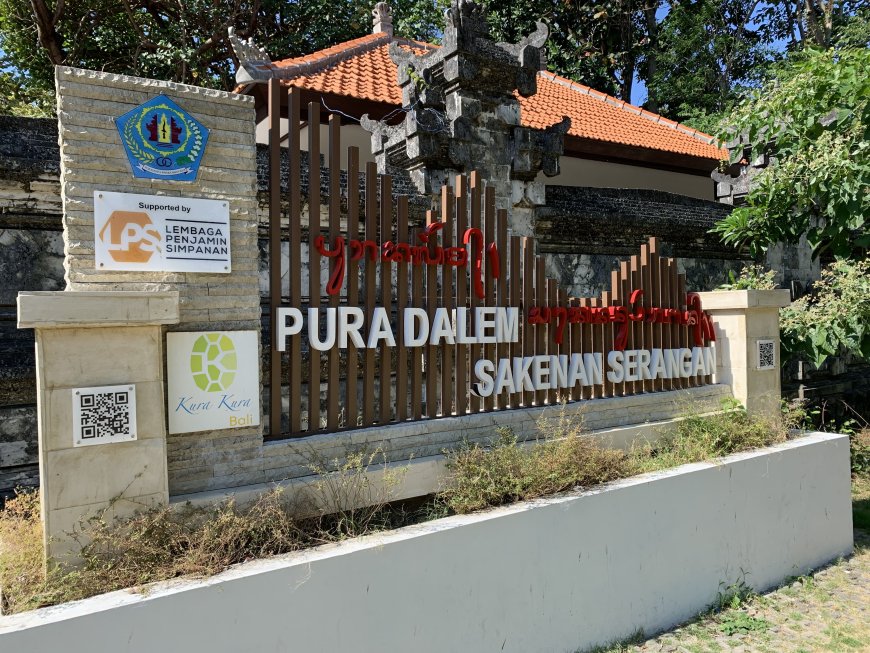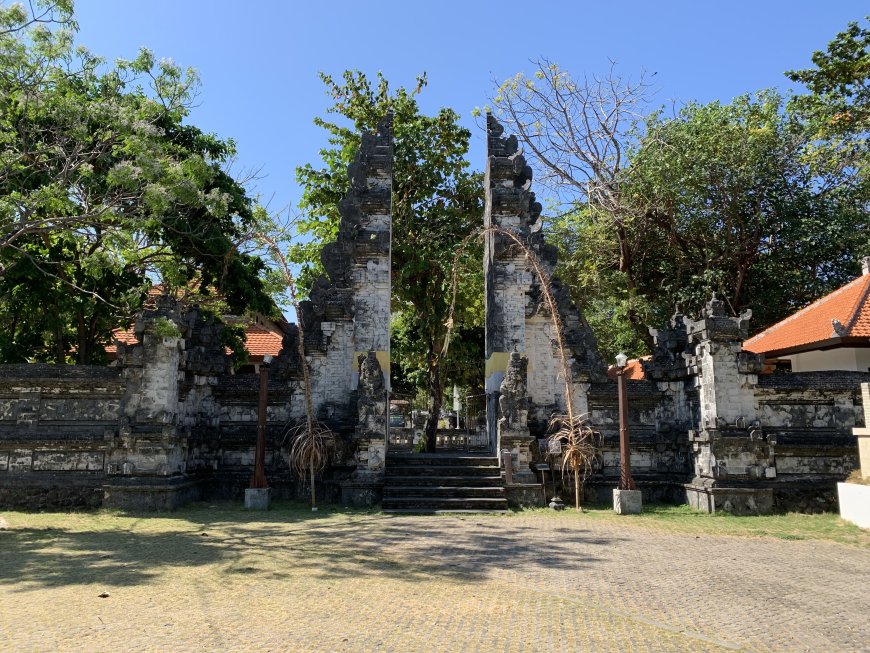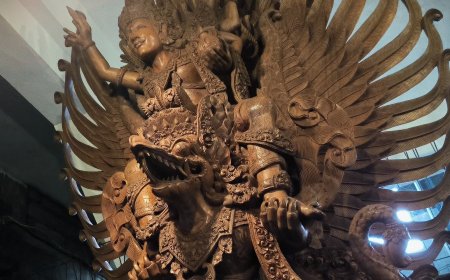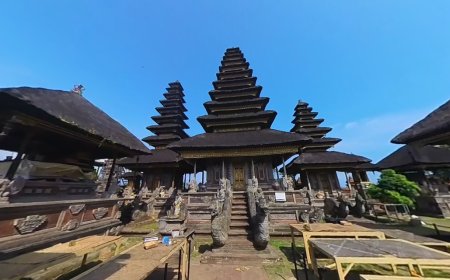Pura Dalem Sakenan: A Symbol of Religious Harmony and Hindu-Balinese Togetherness
Pura Dalem Sakenan in Denpasar, Bali, reflects the harmony of Hinduism and Buddhism. This temple is important for Hindus in maintaining tradition, nurturing culture, and bringing communities together. In the past, access was difficult, but now it is easier with transportation infrastructure. The Periodalan ceremony emphasizes the importance of togetherness and social responsibility. Pura Dalem Sakenan is a place of worship and a symbol of cultural diversity.

A temple in general is a place of worship for Hindus that is used to worship God Almighty in all aspects, The purpose is to worship God in all his manifestations. At first, the terms "kahyangan" or "hyang" were used before the term "pura" became more common. The term "temple" began to be recognized in the 10th century, especially after the arrival of Empu Kuturan in Bali who brought great changes in religious life in Bali.
Pura Dalem Sakenan, located in the city of Denpasar, Bali, is one of the Dang Kahyangan Temples that has an important role in the lives of Hindus. This temple is not only used as a place of worship, but also used as a symbol of harmony between Hinduism and Buddhism, as well as a rich Hindu-Balinese cultural heritage. Pura Dalem Sakenan has a major role in helping Hindus carry out religious obligations, maintaining religious traditions, and caring for Hindu-Balinese cultural heritage. One of the unique characteristics of Pura Dalem Sakenan is that the temple is characterized by Shiva-Buddhism. This reflects the harmony between Hinduism and Buddhism in Bali, with the influence of Hinduism and Buddhism having long been united in the spiritual traditions and beliefs of the Balinese people. The name "Sakenan" is believed to be derived from the word "Sakyamuni," which refers to Gautama Buddha, emphasizing the harmony between these two religions.
During the reign of Dalem Waturenggong in Gelgel, around 1460-1550 AD, Dang Hyang Niratha came to Bali. On his way, he arrived in Bali and built many shrines, now known as Pura Dang Kahyangan. In 1489 AD, during the reign of Ida Dalem Waturenggong in Gelgel, Dang Hyang Niratha arrived in Bali with the aim of perfecting Hinduism on the island. He stayed in Gelgel for a while before deciding to travel around Bali. During his journey, Dang Hyang Niratha built many temples, such as Rambut Siwi Temple in Jembrana, Tanah Lot Temple in Tabanan, Uluwatu Temple in Pecatu, Bukit Gong Temple in Nusa Dua, Bukit Payung Temple in Nusa Dua, Sakenan Temple in Serangan, Air Jeruk Temple in Gianyar, Tugu Temple in Tegaltugu, Tengkulak Temple in Tulikup Gianyar, and Goa Lawah Temple in Klungkung (Sastrodiwiryo, 2010: 67).

The entrance of Sakenan Serangan Temple (Collection: Editor)
The architecture of Pura Dalem Sakenan is fascinating, especially the main palinggih known as Palinggih Bebancihan. It combines elements of a Hindu padmasana with Buddhist temple forms, creating a strong visual illustration of the harmony between these two religious traditions. The building structure within Pura Dalem Sakenan is an important element that cannot be separated from the existence of this temple. In general, the large temple consists of three distinct parts: Nista Mandala (jabaan or front yard), Madya Mandala (middle yard), and Uttama Mandala (inner yard) (Netra, 1994: 90). In the jabaan or front yard of the temple, there are various types of pelinggih buildings such as Bale Kulkul, Bale Wantilan, Bale Pewaregan, and Jineng (Netra, 1994: 90). In the center or middle jaba, there are usually various buildings such as Bale Agung, Bale Pagongan, and others (Netra, 1994: 90). In Pura Dalem Sakenan, in Madya Mandala and Uttama Mandala, there are several pelinggih or buildings, among others:
Madya Mandala (Central Courtyard)
- Pelinggih Bebancihan: A place of worship to Hyang Sandhijaya or Hyang Baruna, as well as a tribute to Dang Hyang Niratha.
- Bale Tajuk Sthana Ida Bhatara Rambut Sadana Sakenan: A shrine dedicated as the sthana of Ida Bhatara Rambut Sadana Sakenan.
- Bale Tajuk Upakara Place or Offerings: A sacred building used to perform upakara and offerings.
- Bale Tajuk Sthana Ratu Tuwan Kemedan Bhatara Surengrana: Organizes all types of ceremonies and upakara held.
- Bale Tajuk Sthana Ratu Tuwan Kemedan Bhatara Jayengrana: In charge of organizing and supervising various forms of ceremonies and upakara.
- Bale Pesanekan or Storage Bale: A place used to store various types of pengangge or clothing used in the temple.
- Bale Pesanekan: The resting place of Jro Mangku Sakenan: A place provided to rest by Jro Mangku Sakenan.
- Apit Lawang (Togog Dewa Kala): A giant statue that is the embodiment of God Kala.
- Apit Lawang (Togog Pig): A pig statue that is considered the pet of Ida Bhatara Gunung Agung (Wisparina, 2013: 63).
Uttama Mandala (Inner Courtyard)
- Kurung Temple: The temple that connects the "main mandala" with the "middle mandala," surrounded by two Ganesha statues.
- Pelinggih for Jro Dukuh Sakti: A shrine dedicated to the worship of Jro Dukuh Sakti.
- Meru Tumpang Tiga: A sacred structure that serves as a place of reverence for Batara Batur, Intaran, and Ida Batara Muter.
- Gedong Jati: A sacred structure dedicated to Ida Ratu Ayu.
- Gedong (Tajuk) for Batara Buitan and Batara Muntur: A place used in the worship ceremony of Batara Buitan and Batara Muntur.
- Bale Gede or Bale Paruman: A building that functions as a meeting place for the pemangku, a place to purify the pratima of Ida Batara, and a place for sulinggih and kings when there is a pujawali ceremony in the "main mandala."
The Piodalan ceremony at Pura Dalem Sakenan has a deep meaning, including the application of the concept of Social Theology. This concept teaches that every individual is an integral part of society, and they have the responsibility to help realize the teachings of their religion in everyday life. In the Piodalan ceremony, the concept of social theology is reflected in the sense of togetherness of Hindus who gather to worship God at Pura Dalem Sakenan. They jointly participate in the preparation and execution of the ceremony, showing awareness of their role in the social system and the importance of supporting each other in realizing the teachings of their religion.






























































